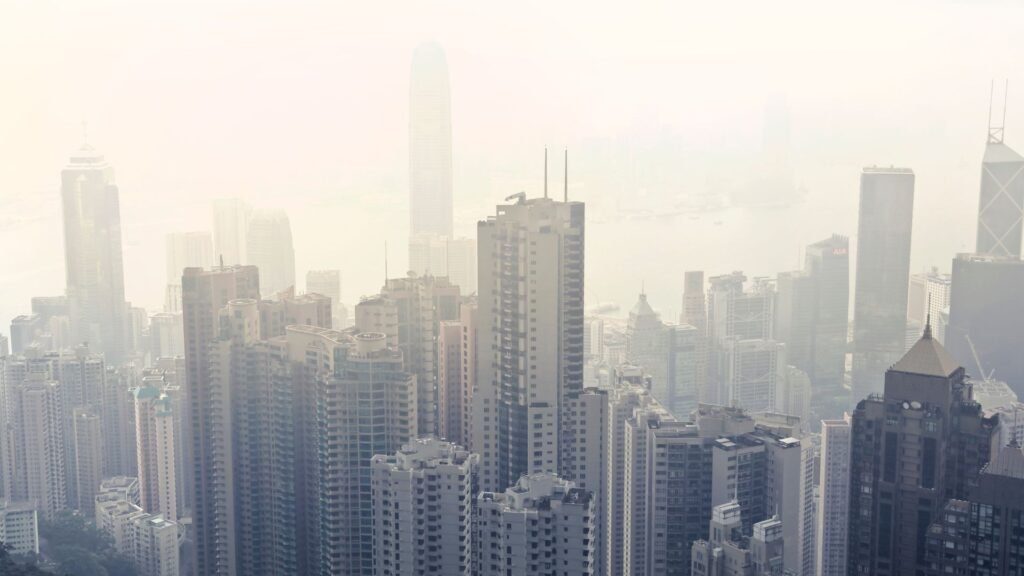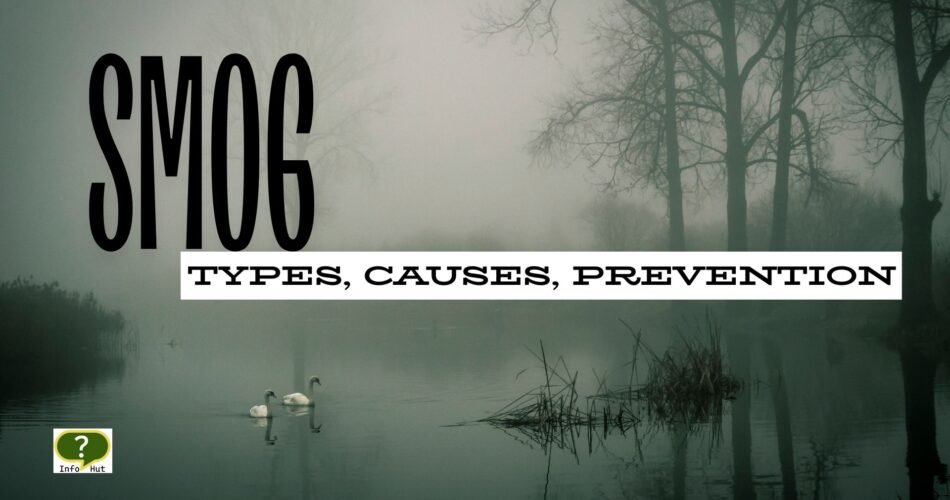This blog contains information about Smog Types, Causes and Prevention. Sulfurous and Photochemical Smog are a severe Effect of Air Pollution that is occurring in some cities of Pakistan in present days. We should be aware of their Causes, Effects and Prevention to avoid its extreme use.
What is Smog?
Smog can be defined as a mixture of Atmospheric Pollutants with dust and smoke combined. Smog is the Type of Air Pollution that reduces visibility and form thick haze into the Environment.
The Smog is an extreme condition of Air Pollution. It is forms at places where the Air Pollution is on extreme and it acts as the worse effect of the Air Pollution. Smog involves many toxic Air Pollutants in its formation. These pollutants have dangerous Effects on Plants, Animals and Human Beings. We will have a Complete description of Types of Smog, Causes, Effects and Precautions of Smog in detail.
Smog is attacking many cities of Pakistan now a days. Multan and Lahore are at the top among the Polluted Cities. These cities contains worse levels of Air Pollution because of the Accumulation of Toxic and Major Air Pollutants in the Atmosphere. Some of the major Pollutants are mentioned below, which are constituents of Smog Formation:
Gases Involved in Smog Formation:
- Tropospheric Ozone
- Particulate Matter
- Carbon Monoxide
- Nitrogen Oxides
- Sulfur Oxides etc.
These are some of the gases that involves in Smog Formation. Lets talk about Smog in detail.
Explain the Types of Smog.
Smog is dangerous in every form, every state and every extent. It can be less or more harmful but it is never harmless in any way. As it produces into the Environment, it starts harming the Biodiversity and normal living systems on Earth. There are two main types of Smog. We will discuss each of the Types in detail.
1. Sulfurous Smog:
First type of Smog is called as the Sulfurous Smog. Sulfurous Smog is characterized by high concentrations of Sulfur Oxides in the air. The main cause of Sulfurous Smog are Natural or Anthropogenic emissions of Sulfur Oxides in the Atmosphere. This type of Smog is highly injurious to Health of Humans and other Biodiversity on Earth. It is produced in the colder temperatures, when Major Air pollutants combines with water droplets and suspends into the Air. It may cause Irritation in the Respiratory Tract, Eyes, Nose and also may trigger Respiratory Disorders such as Asthma, Tuberculosis, Lung Inflammation etc.
First Appearance:
The Sulfurous Smog was first time observed in 1952 in London, and it leads to the death of Thousands of People in London.
Major Sources of Sulfurous Smog:
- Volcanic Emissions
- Burning of Fossil Fuels
- Transportation etc.
Example of Sulfurous Smog:
The Smog that reduce visibility in Multan and Lahore is the Sulfurous Smog. etc.
2. Photochemical Smog:
The second Type of Smog is Photochemical Smog. Photochemical Smog is characterized by the oxidation reaction of Nitrogen Oxides and Sulfur Oxides with the Sunlight. This type of smog produces in the presence of Sunlight of high intensity. Photochemical Smog is invisible with naked eye. But unfortunately it is equally and sometimes more dangerous than the Winter Smog or Sulfurous Smog. This is an oxidizing reaction between Pollutants and Sunlight. It can also make you irritable by interfering your Respiratory System and may hurt your eyes and nose. Photochemical Smog is taken for granted as compared to Sulfurous Smog, but the same precautions must be taken in both conditions.
First Appearance:
The Photochemical Smog was at first observed in Los Angeles, in the year 1950. It showed extreme impacts on Humans and other Biodiversity forms.
Major Sources of Photochemical Smog:
- Industrial Activities
- Wild Fires
- Volatile Organic Compounds etc.
Example of Photochemical Smog:
The smog created in the presence of extreme Sunlight and peak summers in Urban Areas is Photochemical Smog. etc.

What are the Natural Causes of Smog Formation?
Natural Causes are completely dependent on Natural Processes and Natural Phenomena. Anthropogenic or Artificial Causes may only trigger the Natural Causes and accelerate or speed up their effects. But any Artificial Cause or Strategy cannot stop or Control the Natural Causes of Smog Formation in the Environment. Following are some natural Causes of Smog Formation:
i. Volcanic Eruptions:
The Volcanic Eruptions are completely Natural Process of bringing out Lava from the deepest layers of the Earth to Earth’s Surface. But unfortunately it needs a great force to erupt and takes a huge concentrations of SOX, NOx, COX and Particulate Matter burst out with lava. This cause direct addition of tons of Air Pollutants directly into the Atmosphere and cause Atmospheric Pollution. These pollutants then revolves throughout the Earth’s Atmosphere and cause the Smog Formation as it gets cold weather conditions on the surface of the Earth. This is the biggest Natural Cause of Smog Formation.
ii. Wildfires:
Wildfires are the Natural Phenomena in which forests and wild areas are set on fire as the result of lightening, extreme heat or any other natural reason. This can destroy the complete Biodiversity hotspots within hours because the fire is uncontrollable in this condition. Wildfires are big sources of Carbon Dioxide and Carbon monoxide emissions most commonly. While burning Biomass and Biodiversity also adds, NOx and SOX into the Environment. This adds a huge amounts of Air Pollutants into the Air and also raise the levels of Air Pollution into the Atmosphere, ending up in Smog Formation.
iii. Atmospheric Conditions:
As we already know all the Air Pollutants gathers in the atmosphere and then they are spread in different parts of the atmosphere. The atmospheric conditions plays an important role in increasing or decreasing the concentrations of Major Air Pollutants into the Atmosphere. Because atmospheric conditions cause the dispersion or compaction of Air Pollutants in the Atmosphere. This decides the intensity and extent of Smog in different parts of the Atmosphere so these Atmospheric Conditions influence the Smog formation in every possible way.
iv. Weather Patterns:
Weather is the short term Climatic Conditions of a region. The Weather Patterns may vary at irregular intervals causing alteration and disturbance of the Atmospheric conditions. These may involve Storms, Hail, Heavy rainfall, sand storm etc. Weather patterns also influence and leads to the situation of Smog Formation. They can disperse or expand the pollutants over a large Atmospheric region or may isolate the Air pollutants at a specific region. In this way, changing weather patterns can effect the Smog formation at a great extent.
These are some of the Natural Causes of Smog Formation. This blog contains Types, Causes, Effects and Prevention of Smog in detail.
What are the Anthropogenic Causes of Smog Formation?
Anthropogenic Causes of Smog mostly relates to the Anthropogenic Emissions of Major Air Pollutants. Following are some Anthropogenic Causes of Smog Formation.
1) Industrial Activities:
Industrial Activities include the Manufacture, Processing, Transportation, Consumption and disposal of the products that are produced in Industries. Burning of Fossil Fuels is a common Activity among Industrial Activities. This burning add COX, SOX and NOx into the atmosphere in great concentrations through chimneys. These gases when accumulate at a single location and cause Air Pollution, they end up forming Smog during the favorable temperature and conditions.
2) Transportation:
Transportation is the use of vehicles for travelling from one place to another. There are different types of vehicles that’s drive depends upon Fuel. These Fuels are mostly Carbon, Sulfur or Nitrogen containing fuels. When these fuels are burned in the engines of the vehicles, they emit harmful air Pollutants such as Carbon Monoxide, Carbon dioxide, Nitrogen Oxides and Sulfur Oxides into the atmosphere. It eventually results in severe Air Pollution that can anytime turn into Smog.
3) Agricultural Emissions:
Due to exponential increase in Population Growth, the Agricultural industry is using Non-sustainable Agricultural and Farming Practices in order to meet the needs of current population. The Farmers focus on increasing their yield rather than protecting the Environment. Most of the time they use Fertilizers and Pesticides to increase their yield and perform Intensive Farming. This play a great role in the Nitrogen and Sulfur emissions in the Environment. They become part of Smog afterwards.
4) Deforestation:
Deforestation refers to cutting down of the Trees for the welfare of Human Beings. It can be for different reasons i.e. Urbanization, Construction Projects, Road construction, or Resource Utilization. As we know that, Forests are Natural Carbon sinks and also a Sustainable way to Fight with Air Pollution, Global Warming and Climate Change. Trees cleanse the Air and makes it free from the Major Air Pollutants that contributes a lot in Air Pollution. The Deforestation leads to deterioration of Air Quality and is a cause of Smog.
These are some of the main Anthropogenic Causes of Smog Formation. This blog contains Types, Causes, Effects and Prevention of Smog.
What are the Effects of Smog on the Environment?
Following are some of the Effects of Smog on Environment:
- Smog is the reason of many Respiratory disorders and also Respiratory conditions in Humans and Animals, that may disturb their normal living.
- It interferes the food making process of the Plants by restricting or reducing Photosynthesis. Eventually in extreme conditions, the leaves may damage or die.
- This climatic condition can disrupt the Migration, Habitat, Life processes and even Reproduction process in animals due to changes in Environmental Conditions.
- Smog can enhance the Ocean Acidification that can kill, harm or destroy Aquatic Species. It can also damage the Coral Reefs with increased Acidity.
- It reduces visibility that increase the risks of Accidents in Human life and even in Animals.
These are some of the Effects of Smog on the Environment. This blog contains Types, Causes, Effects and Prevention of Smog in detail.
What are Preventive Measures for Smog Formation?
Following points shows the ways by which we can prevent Smog Formation:
- Avoid any type of Burning before and during the Smog Season.
- Promote Electric Vehicles to reduce the emissions produced by Conventional Vehicles.
- Don’t use extra light sources to avoid excessive CO2 emissions and also other effects of Light Pollution.
- Utilize Renewable Energy instead of Fossil Fuel Burning. This will cast a significant impact on the emissions of Air Pollutants.
- Remove Nitrogen and Sulfur from the Fuels before their burning.
- Use scrubbers to remove harmful pollutants from the emissions before emitting into the Environment and also the Atmosphere.
These are some Prevention Strategies for Smog Formation. This blog contains Types, Causes, Effects and Prevention of Smog in detail.

To learn about More Topics, Click the links below:


Comments